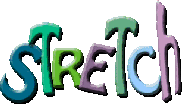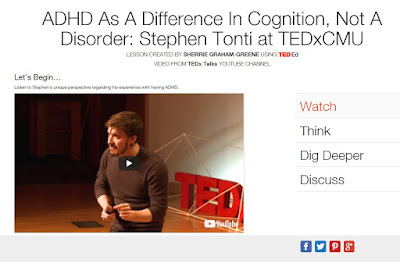This video was a game changer in my thinking and made me wonder...
WHY do we need to "label" students in our schools? ALL children learn differently and we need to embrace these differences as a society. I have become extremely disenchanted with schools and teachers that say, "well...he/she is special education...there is nothing I can do (as the regular classroom teacher)."
While there are MANY great teachers out there who own the education of all their students, the mantra needs to be 'They are all my students - Every Day!' Whether the teacher has the student in a class, or he/she encounters a student in the hallway, children want to live up to the high expectations that we set for them. Too many times I have seen a teacher ignore the behavior of another student as, "they are not my student."
Please view this video and feel free to comment on the identification of students within our school system and how this affects the maximum potential of EACH one!
Sunday, July 10, 2022
Friday, May 6, 2016
Definition of Giftedness
The following represent a variety of definitions of "giftedness":

Giftedness is asynchronous development in which advanced cognitive disabilities and heightened intensity combine to create inner experiences and awareness that are qualitatively different from the norm. (The Columbus Group, 1991)
The term "gifted and talented students" means children and youth who give evidence of high performance capability in areas such as intellectual, creative, artistic, or leadership capacity, or in specific academic fields, and how require services or activities not ordinarily provided by the school in order to fully develop such capabilities. (US Congress revision of the Maryland report of 1972 in 1988 - P.L. 100-297, Sec. 4103, Definitions)
Sternberg's five "necessary and sufficient conditions that gifted persons have in common":
- Excellence: A gifted person must be extremely good at something.
- Rarity: He or she must posses a high level of an attribute that is uncommon relative to peers.
- Productivity: The superior trait must (potentially) lead to productivity.
- Demonstrability: The trait also must be demonstrable through one or more valid tests.
- Value: The superior performance must be in an area that is valued by society.
(Davis and Rimm, 1998, p.23)
Joseph Renzulli's Three-Ring Model

"Gifted behavior...reflects an interaction among three basic clusters of human traits - these clusters being above average (but not necessarily high) general and/or specific ability, high levels of task commitment (motivation), and high levels of creativity. Gifted and talented children are those possessing or capable of developing this composite set of traits and applying them to any potentially valuable area of human performance." (quoted in Davis and Rimm, 1998, p. 19)
What is your definition of giftedness?
Thursday, May 5, 2016
Creativity and Problem Solving
In the pursuit of "STRETCh'ing" student learning and meeting the needs of those students who are ready for the "Next STEP", The Center for Creative Learning has a wealth of resources for helping to engaged talented problem solvers. Many times students who are talented in the area of acquiring content knowledge quickly become disengaged with school out of boredom.
As schools shift to meeting the needs of 21st century learners, you will see more brain-based strategies and problem-solving application of content assessments.
Wednesday, May 4, 2016
Center for Gifted Education College of William and Mary
I found the following document that is an individual instruction plan "Menu" for the gifted child.

The vast majority of items on the list seem to be good for ALL children. I think programming for the gifted is not as simple as this list makes out.
With gifted students it is the asynchronous learning that needs to be accommodated for!
It is not a one size fits all. The above model is not account for the asynchronous learning either. Tier 4 should be available as needed - not after formal identification.
As parents, you need to be armed with this information! If your child is great at Geometry and is working above grade level in that area only, you have a right to ask for their learning to be differentiated.
Sunday, April 3, 2016
Whack!
With the shift toward CCSS and the mathematical practices, what better way to incorporate them! In this gamified version, students WHACK the gopher over his head once they master the mathematical practices.
What does it mean?
- Understand the meaning of the problem by looking for entry points to its solution
- Analyze the information (givens, relationships, constraints, outcomes)
- Design a plan
- Monitor and evaluate the plan and change course as necessary
- Checks for understanding by asking "Does this make sense?"
- Sticks with the problem - Does not give up easily.
How do I solve it?
- Makes sense of quantities and relationships
- Represent a problem symbolically
- Considers the units involved
- Understands and uses properties of operations
- Considers many different strategies when deciding how to solve the problem
Application of strategies
- Looks for patterns or structure
- Uses models to solve problems
- Looks for the big picture or overview
- Knows and can select the appropriate tools for the problem (calculator, ruler, pencil/paper, concrete model, compass, protractor)
- Notices repeated calculations and looks for general methods and shortcuts
- Makes assumptions and estimations to make a problem simpler
Check for accuracy
- Calculates accurately and efficiently
- Labels accurately when measuring and graphing
- Uses appropriate unit labels
- Checks to see if an answer makes sense, and changes model/strategy when needed
Knowledge I used
- Uses definitions and previously established causes/effects (results) in constructing explanations
- Communicates answers by using appropriate mathematical vocabulary
- States the meaning of symbols
- Communicates and defends mathematical reasoning using objects, drawings, diagrams, actions
- Decides if the answers of others make sense
- Asks questions needed for clarifying and understanding
Subscribe to:
Posts (Atom)













